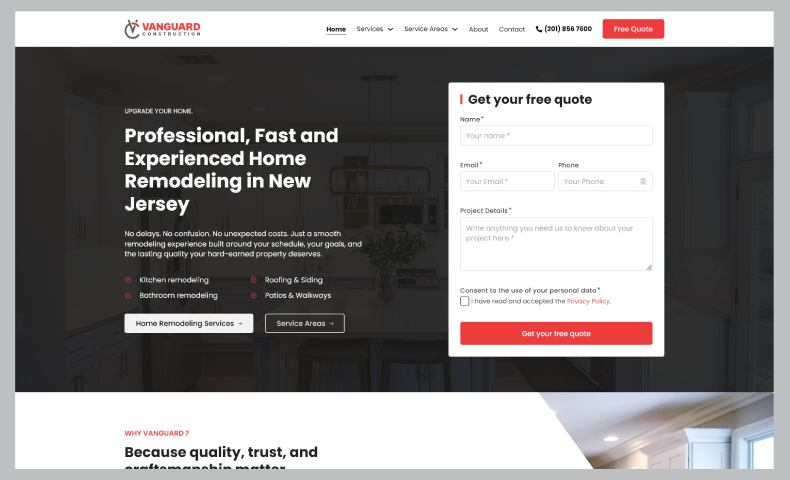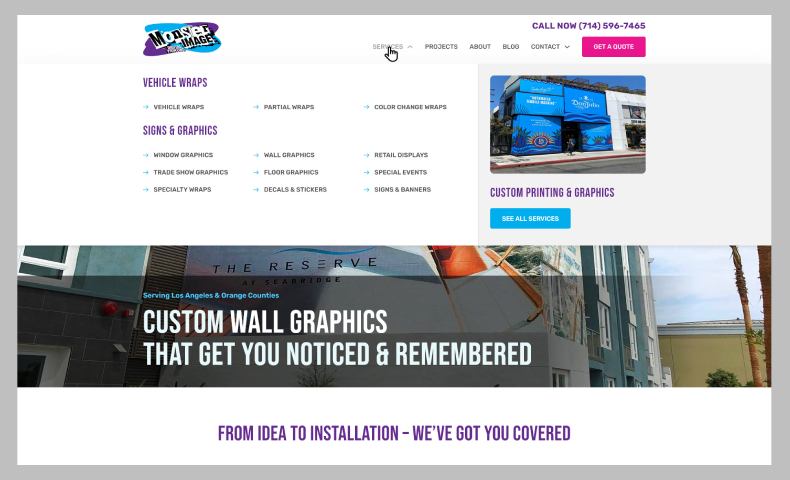When a potential customer lands on your website, their decision to stay or leave happens in seconds. For local service businesses, your website isn’t just a digital brochure — it’s often the first impression someone has of your business.
And yet, many local businesses overlook one of the most critical factors in online success: the structure of their site.
How your pages are organized, what content lives where, and how easy it is to navigate can directly impact:
- How well you rank in search engines
- How confident people feel in your business
- Whether or not they convert into a lead
In this guide, we’ll walk you through how to structure a local business website that not only looks great — but works hard behind the scenes to bring you customers.
Why Website Structure Matters for Local Service Businesses

When someone visits your site, they’re usually not there to browse for fun — they have a specific need. Maybe they’re looking for a plumber, a landscaper, or a local accountant. They want fast answers, clear paths, and zero friction. That’s where your website structure becomes make-or-break.
It Impacts SEO
Search engines like Google use your site’s structure to understand what your business offers and which pages are most important. A logical structure helps Google crawl and index your pages more efficiently, understand how your services are related, and serve the right pages to local searchers. A scattered or overly complex site can hurt your rankings, especially for long-tail, local keywords.
It Shapes the User Experience
Customers aren’t just looking for a service — they’re evaluating your credibility. A clean, easy-to-navigate website sends the message: “This business is professional, trustworthy, and knows what it’s doing.”
A confusing structure, on the other hand, can feel unprofessional or even outdated.
Stat: 38% of users will stop engaging with a site if the layout or structure is unattractive.
(Sweor)
It Drives Conversions
A smart site structure isn’t just about organization — it’s part of your conversion funnel. It guides users from the moment they land on your website all the way to a decision: learn who you are, explore your services, trust what they see, then take action. The more seamless that journey, the more likely they are to reach out.
Must-Have Pages on a Local Service Business Website

The foundation of a strong website is making sure you have the right pages in place. Local service businesses don’t need dozens of pages, but they do need a clear structure that covers all the essentials customers look for. Skipping even one of these can leave gaps in both trust and visibility.
Home
The homepage is the anchor for your brand online. It sets the tone, gives a quick overview of your services, and points visitors to where they should go next.
About
Customers want to know who they’re hiring. An About page adds credibility by showing the people behind the business, your story, and your values.
Services
Each core service deserves its own page. This not only helps customers find exactly what they need but also makes it easier for search engines to rank you for specific service-related keywords.
Service Areas
Local SEO depends on showing where you work. A Service Areas page allows you to target nearby towns or neighborhoods. You don’t need dozens of pages right away — start with the most important locations and add new ones over time.
Contact
The Contact page is often the make-or-break point. It should give customers multiple ways to reach you, including a form, phone number, and address or service area.
Testimonials or Reviews
Social proof is especially powerful for local businesses. A page dedicated to client reviews or case studies helps potential customers feel confident choosing you.
Blog or Resources
A blog adds depth to your site. It gives you a place to share helpful content, improve SEO, and demonstrate that you know your industry. Even a handful of well-written posts can make your website feel more established and authoritative.
Pro Tip: For SEO, each of these pages should include keywords tied to your location and services. For example, “affordable lawn care in Middletown” or “24/7 emergency electrician in Hartford.”
Smart Navigation: Structure That Works for Humans and Google

A well-structured navigation menu is the backbone of your website. For local businesses, it needs to do two things equally well: make it easy for people to find what they need, and make it clear to search engines how your site is organized.
Keep It Simple
The best navigation menus are short and straightforward. Aim for five to seven main items in your header menu. Anything more can overwhelm visitors and dilute focus. For example: Home, About, Services, Blog, and Contact.
Group Pages Logically
If you offer multiple services, group them under a Services dropdown. This keeps your main navigation clean while still making each service page accessible. Visitors should never have to click more than once or twice to get where they want to go.
Use Clear Labels
Avoid jargon or clever wording. People scan menus quickly and need instant clarity. Instead of “Solutions” or “Capabilities,” use direct labels like “Plumbing Services” or “Landscaping Design.”
Optimize for Mobile
More than half of local business website traffic comes from mobile devices. Make sure your navigation is just as clear and easy to use on a phone as it is on a desktop. A mobile-friendly sticky header or well-designed hamburger menu ensures users can always access key pages.
Support SEO with Structure
Navigation isn’t just for people — it’s also a strong SEO signal. Internal links in your menu help Google understand your site hierarchy. For instance, linking all your service pages under a Services dropdown tells Google they’re related but distinct offerings.
Don’t Forget Your CTA
Your navigation is also a great place to include one primary call to action, such as “Get a Free Quote” or “Book a Consultation.” Placing this in the top right corner of your header makes it visible on every page without being pushy.
What to Put Where: Content and CTAs That Guide Visitors

Knowing which pages your site needs is the first step. The next step is deciding how to organize the content within those pages so visitors understand your offer quickly, feel reassured, and are prompted to take action at the right time.
A well-structured page follows a natural flow: introduce the purpose, explain the value, support it with proof, and end with a clear next step. Here’s how that looks across your core pages.
Home Page: Start with Clarity
The homepage should act as a quick elevator pitch.
- Top of the page: A headline that says what you do and where you do it, followed by a primary call to action.
- Middle: Highlights of your main services with links to individual service pages.
- Lower down: Social proof like testimonials or trust badges, plus a secondary call to action.
Service Pages: Solve Problems and Reduce Hesitation
Each service page should be focused on answering two questions: “Can you fix my problem?” and “Why should I trust you to do it?”
- Top: State the service clearly with a headline that includes a local keyword (e.g., “Residential Roofing in West Hartford”).
- Middle: Explain benefits, show before-and-after examples, and include short FAQs specific to that service.
- Bottom: A strong, unmissable call to action such as “Book Your Free Estimate.”
About Page: Build Confidence
Visitors land here to decide if they feel comfortable with you.
- Top: A concise company story or mission statement.
- Middle: Team photos, values, or credentials that make you relatable and trustworthy.
- Bottom: Link back to your services or contact page so visitors don’t hit a dead end.
Contact Page: Remove Friction
This page should be the simplest on your site.
- Top: Contact form and clickable phone number.
- Middle: Google Map embed and hours of operation.
- Bottom: Reinforce your service area or main value proposition.
Blog/Resources: Educate While You Rank
Each blog post should follow the same content hierarchy:
- Top: Clear headline that matches a search intent.
- Middle: Practical, easy-to-skim advice with visuals or bullet points.
- Bottom: A CTA that ties the content back to your services (e.g., “Need help implementing this? Let’s talk.”).
Avoid These Common Structure Mistakes

Even with the right pages and navigation in place, it’s easy to fall into traps that limit how effective your site can be. These are the mistakes we see most often when reviewing local business websites.
Overloaded Navigation
When your menu tries to do too much, visitors don’t know where to click. A clean structure with a few clear options always outperforms a long, cluttered menu.
One-Page Service Descriptions
Putting all your services on a single page weakens both user experience and SEO. Each service should have its own page so you can provide the detail, proof, and calls to action that convert visitors into leads.
Weak or Hidden Calls to Action
If a visitor has to hunt for your phone number or booking form, you’ve already lost them. CTAs should be visible on every core page, placed consistently near the top and again at logical stopping points further down.
Skipping Local SEO Signals
Leaving out references to your service area is a common oversight. Make sure your town, city, or neighborhood names appear naturally in your page titles, headings, and content so search engines can match you to local intent.
Overlooking User Experience
Even if your structure is correct on paper, poor design choices can undo all the benefits. Hard-to-read text, slow-loading pages, or layouts that don’t guide the eye can frustrate visitors and cost you leads. For a deeper dive into avoiding these pitfalls, see our article on UX tips for service-based websites that want leads.
Conclusion: Building a Local Business Website That Works
A well-structured website does more than look good. It helps people find you, builds trust in your services, and makes it easy for potential customers to take the next step. For local businesses, the right structure can be the difference between a website that simply exists online and one that consistently brings in leads.
By focusing on essential pages, keeping navigation simple, placing content and calls to action strategically, and avoiding common mistakes, you’ll create a website that works for both search engines and real people.
If you’re ready to build or redesign your site with a structure designed for growth, we can help. Book a free consultation.

